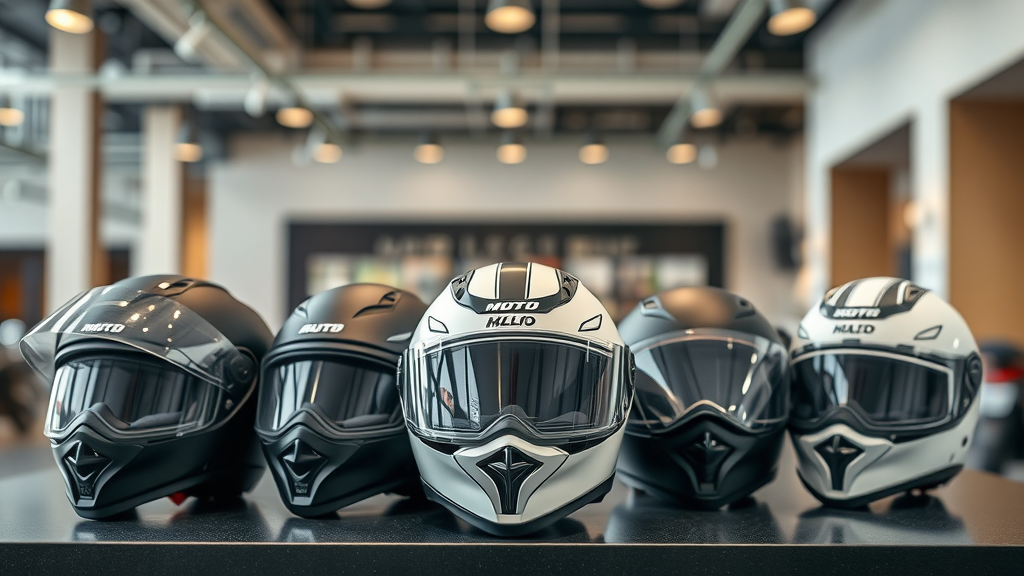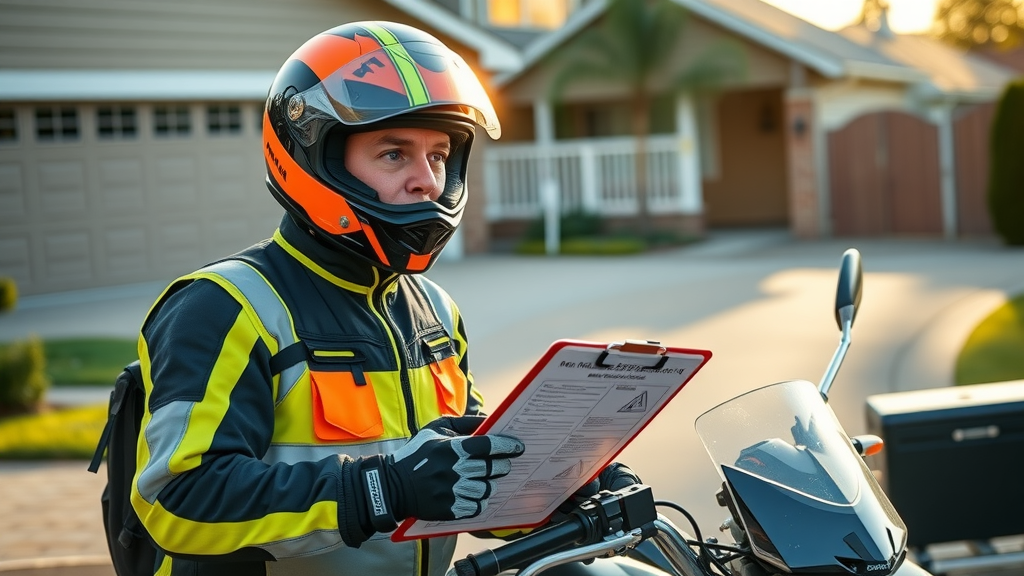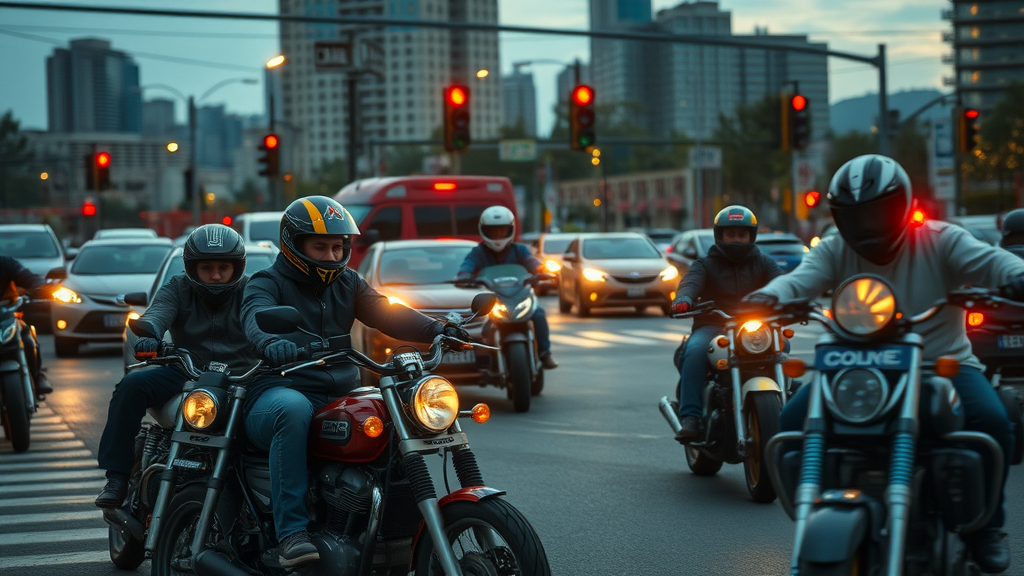Did you know that motorcycle accidents have a fatality rate 27 times higher than car accidents? Each year, nearly 5,000 motorcyclists lose their lives on U.S. roads—most in avoidable crashes. With the open road offering both thrill and risk, mastering motorcycle accident prevention isn’t just about riding—it’s about surviving and thriving. Whether you're a new rider or a seasoned enthusiast, the most important ways to safeguard your journey are just ahead. Let’s explore the must-know facts and actionable strategies that every motorcycle rider should follow for ultimate motorcycle safety .
Shocking Realities: Motorcycle Accident Statistics Every Rider Should Know
- Nearly 5,000 motorcyclists die in crashes each year in the US
- Motorcycle accidents have a fatality rate 27 times higher than car accidents
- Over 50% of all motorcycle crashes involve another vehicle

"Riding a motorcycle may feel freeing, but reckless decisions and poor habits can have irreversible consequences."
The numbers speak volumes: motorcycle accidents are both common and devastatingly lethal compared to other modes of transport. The National Highway Traffic Safety Administration reports that despite accounting for fewer vehicles on the road, motorcyclists suffer a disproportionately high percentage of traffic fatalities and injuries. More than half of these motorcycle crashes involve another motor vehicle , meaning that awareness of both your actions and those of other drivers is crucial. These realities set the stage for why motorcycle accident prevention strategies are not just 'nice-to-haves', but absolute necessities for every motorcycle rider .
Motorcycle Accident Prevention: Why It Matters for Every Motorcycle Rider
Motorcycle accident prevention is vital for every motorcycle rider, regardless of experience or riding frequency. Because motorcycles offer minimal physical protection compared to cars, the consequences of any crash are almost always more severe. Effective prevention strategies—like consistent use of proper gear, skill development, and compliance with traffic safety laws—not only help save lives but also reduce the risk of life-altering injuries. By embracing a culture of motorcycle safety and responsible riding, every rider contributes to a safer, more respectful environment for everyone on the road.
Beyond the statistics, every motorcycle accident represents not just a data point, but a community member, friend, or family member. Improving motorcycle accident prevention starts with acknowledging the unique vulnerabilities of motorcycle riders . Committing to ongoing education, preparedness, and a safety-first mindset forms the cornerstone of accident prevention and long-term well-being on the open road.
Assessing the Risks: Common Causes of Motorcycle Accidents and How to Counteract Them
- Speeding
- Distracted driving (by riders or others)
- Poor visibility
- Lack of protective gear
Every rider faces real risks—some within, and some beyond, their control. Speeding dramatically reduces your reaction time and increases the force of impact, while distractions, whether from mobile devices or simply daydreaming, can lead to disastrous lapses in attention. Poor visibility caused by bad weather or other vehicles is another significant danger, especially on crowded urban roads. Lastly, riding without adequate protective gear magnifies the likelihood of serious injury in any motorcycle accident . To counteract these risks, always respect the speed limit, avoid distractions, and never underestimate the value of visible, protective gear.
Counteracting these common risks requires both proactive habits and constant vigilance. Safe riding depends on anticipating hazards like abrupt lane changes from larger vehicles or debris in your path. Wearing reflective gear improves your chances of being seen, while defensive riding techniques help you avoid the negligent errors of other motorists. Remember, in the fight against motorcycle accidents , your knowledge and preparation can be just as important as your braking skills.
Motorcycle Safety Fundamentals: Traffic Laws and Helmet Law Compliance
One foundational aspect of motorcycle accident prevention is strict adherence to traffic laws and universal helmet law requirements. Understanding and following local regulations—including speed limits , lane rules, and equipment mandates—not only helps reduce the risk of collision but also ensures legal protection in the event of a motorcycle crash . Recognizing the critical role of helmet laws should be a priority, as enforced compliance directly correlates with a reduction in severe injuries and fatalities on the road. Responsible riders know that traffic safety begins before the engine starts, with habits rooted in legal compliance and genuine self-respect.
Many states have their own versions of helmet laws , and understanding your responsibilities as a rider is crucial. Regardless of legal minimums, the best practice is to wear a helmet at all times. Remember, motorcycle safety starts with your own actions, but extends to influencing those who ride with you.
What Helmet Laws Mean for Motorcycle Accident Prevention
- State-by-state helmet law overview
- Legal responsibilities and their impact on motorcycle safety

"Studies consistently confirm that proper helmet use reduces the risk of head injury by 69% and the risk of death by 42%."
The implementation and enforcement of helmet laws across different states influence the behavior of riders. States with a universal helmet law (requiring all riders to wear a helmet) consistently show lower motorcycle fatalities compared to those with partial requirements. These laws are not arbitrary—they’re the result of extensive research by organizations like the Highway Traffic Safety Administration and Department of Transportation . Wearing a certified, DOT approved helmet is a simple, proven way to reduce the risk of traumatic brain injury and death in the event of a crash.
Compliance with helmet laws is about more than avoiding fines—it’s about safeguarding your quality of life. When you wear a helmet , you protect yourself from the majority of fatal head injuries and demonstrate respect for both the law and your well-being. No journey is worth the risk of riding unprotected, and every motorcycle accident averted is a testament to the value of legal compliance and proactive motorcycle accident prevention .
Selecting the Best Motorcycle Helmet: Protection and Compliance Guide
Choosing the right motorcycle helmet is a vital element in motorcycle accident prevention . A helmet not only reduces the risk of death and head injury, but also ensures you’re in compliance with state and federal helmet law standards. With advances in technology and design, modern helmets offer high levels of both comfort and protection. Understanding the differences among helmet types—such as full-face helmets , modular helmets , and open-face helmets —enables you to make informed decisions that maximize both safety and legal compliance.
Remember, not all helmets are created equal. Always check for a DOT approved helmet sticker or equivalent certification to ensure your helmet meets the latest department of transportation standards. The right helmet is your most critical defense on any ride, especially in high-risk road conditions or when sharing lanes with unpredictable motor vehicle traffic.
How Wearing a Helmet Prevents Serious Motorcycle Injuries
| Comparison of Helmet Types | DOT Approved | Key Safety Features |
|---|---|---|
| Full-face helmets | Yes | Maximum head and facial coverage, integrated visors, high impact protection |
| Modular helmets | Yes | Chin bar flips up for convenience, suitable for commuting, strong chin/jaw protection |
| Open-face helmets | Yes | Good visibility, lighter weight, less jaw protection |
- Full-face helmets
- Modular helmets
- Open-face helmets

Wearing a helmet reduces the chance of a fatal motorcycle accident by up to 42% and the risk of serious head injury by 69%. Full-face helmets, in particular, provide best-in-class protection—not only for the head but for the entire face and chin, which are commonly impacted in high-speed crashes. Modular helmets offer added flexibility for those who need both safety and ease of use, while open-face helmets , though offering good visibility, lack critical coverage during a high-impact crash. The most effective way to prevent accidents from turning deadly is to invest in and consistently use a properly fitted, approved helmet every time you ride.
The benefits of a helmet extend well beyond legal compliance. The life you save may be your own, but you’ll also spare your loved ones the heartache of preventable injury or loss. With every journey, prioritizing helmet use is a non-negotiable aspect of responsible motorcycle safety —and an actionable, everyday method for motorcycle accident prevention .
Motorcycle Accident Prevention by Improving Your Riding Skills
Developing better motorcycle riding skills is a foundation of motorcycle accident prevention . Far too many crashes result from panicked or inexperienced responses to common hazards—something advanced motorcycle safety training can substantially improve. Even seasoned riders benefit from periodic skill refreshers and up-to-date defensive riding strategies. Being proactive about learning new techniques not only helps you avoid motorcycle crashes but also instills greater confidence and control every time you hit the open road.
By participating in certified safety courses and practical riding drills, you’ll develop the quick reflexes and situational awareness needed to identify and counteract risks before they escalate. This not only helps motorcycle riders but also encourages all motorists to respect the unique challenges faced by those on two wheels.
Advanced Motorcycle Safety Training: Techniques for Safer Rides
- Defensive riding courses
- Obstacle avoidance drills
- Emergency braking practice
Defensive riding courses teach critical skills such as keeping safe distances, predicting traffic flow, and executing evasive maneuvers. Obstacle avoidance drills train you to respond calmly and swiftly to sudden hazards, whether it’s a pothole, debris, or an unexpected motor vehicle encroaching into your lane. Emergency braking practice can be the difference between a close call and a catastrophic motorcycle accident , ensuring you can bring your bike to a stop without losing control. Commit to ongoing education; each skill mastered carries over to every ride, offering a real-world buffer against accidents and injuries.
Continuous improvement in your riding skills is a core principle of motorcycle safety . Investing in skill-building is not a sign of inexperience, but of maturity and responsibility—qualities that save lives on the road every day.
Top Motorcycle Accident Prevention Tips for Everyday Riding
- Obey all traffic rules
- Wear high-visibility gear
- Regularly inspect your motorcycle
- Avoid riding in poor weather
- Stay focused and alert at all times

Integrating accident prevention habits into every ride can make the difference between a safe journey and a serious motorcycle accident . Always start by obeying speed limits and other traffic laws—your compliance sets the tone for overall road safety. Next, choose high-visibility gear which makes you stand out to other drivers, whether in broad daylight or low-light conditions. Routine inspections—checking tire pressure, brake function, and signal lights—ensure your motorcycle is always ready to respond to the demands of the road.
Furthermore, bad weather dramatically increases the risk of crashes. Avoid riding during periods of low visibility, heavy rain, or high winds when possible. Above all, maintain mental focus by minimizing distractions—staying alert is your best protection from the unpredictable nature of the open road.
Motorcycle Rider Positioning: The 4 Second Rule and Lane Management
Strategic positioning is another often-overlooked cornerstone of motorcycle accident prevention . Following too closely or riding in a car’s blind spot limits your ability to respond to sudden changes—a common cause of motorcycle crashes . The ‘4 Second Rule’ is a best practice for creating enough reaction time, especially amid unpredictable traffic patterns or when sharing the road with inexperienced drivers. Lane management, including riding in the lane portion most visible to other drivers, also helps reduce the likelihood of collisions.
Many motorcycle riders wrongly assume that speed alone is a defense against danger. In reality, a proactive approach to lane choice and following distance buys you time and space when seconds count. Making a habit of consistently applying these principles cuts risk while enhancing overall motorcycle safety .
Understanding the 4 Second Rule for Motorcycle Accident Prevention
- How the 4 second rule increases your reaction time during motorcycle accidents
- Proper following distances for motorcycle safety
The 4 Second Rule means keeping at least four seconds of distance between your motorcycle and the vehicle ahead. This buffer allows you to observe, decide, and act when potential hazards arise—whether it’s sudden braking, lane changes, or road debris. To practice, pick a stationary roadside object, and when the car ahead passes it, begin counting “one thousand one, one thousand two, one thousand three, one thousand four.” If you reach the object before you finish counting, you’re too close. Adhering to this rule substantially increases your ability to prevent accidents and handle emergencies.
Mastery of following distance and lane placement reinforces defensive riding habits—essentials for navigating heavy traffic, urban sprawl, or the unpredictability of rural roads. Integrate the 4 Second Rule into your daily riding routine to make motorcycle accident prevention a natural part of every journey.
Motorcycle Crash Hotspots: Where Most Motorcycle Crashes and Motorcycle Accidents Occur
Understanding where motorcycle accidents are most likely to occur gives you a decisive edge in motorcycle accident prevention . Intersections, blind spots, and specific "risky roads" are the most common hotspots. Busy intersections are notorious for left-turning vehicles overlooking oncoming motorcycles, while blind spots in traffic make it easy for drivers to miss you entirely. Rural highways and poorly maintained roads also see a higher incidence of motorcycle crashes due to unexpected hazards and limited visibility. Recognizing these danger zones is the first step in managing your exposure to risk.
Many motorcycle riders are caught off guard not by their own errors, but by the disruptions and distractions of the traffic environment itself. Taking active note of common crash sites and adjusting your riding style accordingly means you’ll be better equipped to anticipate and avoid potentially fatal situations.
Intersections, Blind Spots, and Risky Roads: What Every Motorcycle Rider Must Know
| Location | % of Crashes | Prevention Methods |
|---|---|---|
| Intersections | 50+ | Slow down, make eye contact with drivers, never assume right-of-way |
| Blind Spots | 20 | Avoid lingering beside cars, use lane positioning, high-visibility gear |
| Rural Roads | 15 | Ride at appropriate speeds, scan for debris and wildlife, extra lighting |

Intersections account for the majority of motorcycle accidents , with many caused by drivers making left turns in front of oncoming bikes. In busy city centers, always approach intersections with caution, ready to take evasive action if needed. Blind spots —both yours and other drivers'—are equally treacherous. Avoid riding in areas where you’re less visible to larger vehicles, especially trucks and SUVs. Rural and winding roads, while scenic, present their own set of hazards including sharp curves, loose gravel, and unpredictable wildlife. By proactively identifying and managing these high-risk locations, you take control of your safety.
Are Motorcycle Crash Guards Worth It for Accident Prevention?
- Pros: Added protection, reduced damage
- Cons: Not foolproof, improper guards can add risk
Motorcycle crash guards are designed to provide a buffer between your bike and the ground during a fall or low-speed motorcycle accident . In many scenarios, these guards can help protect critical components and even your legs from direct impact. However, crash guards are not a silver bullet—while they can reduce damage and, in some cases, injury severity, they are not a replacement for riding skill, awareness, or proper gear. It’s essential to ensure guards are properly installed and compatible with your specific make and model, as poorly fitted guards may actually create new hazards.
In summary, crash guards are a smart addition for most riders, but they should be viewed as a supplement to—not a substitute for—comprehensive motorcycle accident prevention strategies. Always focus first on riding fundamentals, gear, and awareness.
Weather Awareness: How Environmental Factors Impact Motorcycle Accident Prevention
- Rain, wind, and poor lighting increase risk
- Adjust riding techniques for changing conditions

Inclement weather is a major contributor to motorcycle accidents . Wet roads reduce traction and increase stopping distances, while strong crosswinds can push even experienced riders off course. Poor lighting—often at dawn, dusk, or in heavy rain—makes it difficult for both motorcycle riders and motorists to see each other. The solution? Plan your rides around the forecast as much as possible, and be ready to postpone trips during inclement weather. When you must ride, reduce your speed, increase your following distance, and use extra caution at intersections.
Having the right gear—such as waterproof clothing and anti-fog visors—and regularly checking your bike’s lights and brakes are essential for motorcycle safety in bad weather. Above all, your willingness to adjust your riding to environmental conditions is a hallmark of a responsible and safety-conscious motorcycle rider .
Motorcycle Maintenance for Accident Prevention: Inspection Checklist
- Tire condition
- Brake efficiency
- Lights and signals
- Fluid levels
Routine motorcycle maintenance plays an unsung but essential role in motorcycle accident prevention . A quick inspection before every ride reduces the likelihood of mechanical failure—a leading cause of solo bike crashes. Start by examining tire tread and pressure to ensure proper grip, especially in wet or challenging conditions. Test your brake system for responsiveness and wear, as a fraction of a second can make all the difference in emergency stops. Confirm that all lights and turn signals are functioning to maximize your visibility to others.
Maintaining fluid levels—oil, brake fluid, and coolant—keeps your motorcycle running smoothly and ensures optimal performance in all conditions. Following this basic inspection checklist each time you ride is a simple, effective way to enhance both motorcycle safety and your peace of mind.
Motorcycle Rider Gear Beyond Helmets: Jackets, Gloves, and More for Enhanced Safety
- CE-rated jackets and pants
- Reinforced gloves
- Reflective accents
Effective motorcycle accident prevention extends far beyond helmets alone. CE-rated jackets and pants , made with abrasion-resistant materials and armor, offer critical protection for your limbs and torso. Reinforced gloves shield your hands from both impact and road rash—the most common injuries in falls. Outfitting yourself with clothing that includes reflective accents improves your visibility in all types of lighting, especially crucial during twilight and nighttime rides. The right gear can transform a potentially devastating accident into a survivable incident.
Never underestimate the cumulative advantage of complete protective wear, as every piece adds another layer of security in the event of a motorcycle crash . Invest in quality, certified gear and make it a nonnegotiable part of your riding routine.
Fatigue and Focus: Avoiding Distractions and Staying Alert to Prevent Motorcycle Accidents
Mental sharpness is as important as physical protection when it comes to motorcycle accident prevention . Fatigue, distractions, and impaired judgment are major factors in countless crashes. Long rides or a lack of sleep slow your reaction times and reduce critical situational awareness. In-helmet conversations, loud music, or navigation devices can divert your attention at the precise moment when full focus is required. Staying drug- and alcohol-free is an absolute must, as any impairment drastically increases your risk of a motorcycle accident .
Prepare for every ride by getting proper rest, limiting distractions, and taking breaks on long trips. Alertness is your number one defense against both the unexpected moves of others and the changing dynamics of the road itself.
Mental Preparedness for Motorcycle Safety
- Rest before riding
- Minimize in-helmet distractions
- Stay drug and alcohol-free
Mental preparedness is the foundation of every safe ride. Start every trip well-rested, and stay aware of your own mental state throughout your journey. Make it a habit to take breaks before fatigue sets in, and avoid pushing yourself in poor physical or emotional states. Creating routines that reinforce your focus will help make motorcycle safety second nature.
Video: Motorcycle Accident Prevention in Action—Expert Demonstrations
Watch real-world scenarios and guided demonstrations highlighting motorcycle accident prevention best practices. These expert-led videos cover everything from hazard recognition to emergency maneuvers—making complex techniques easy to understand and apply. Visual learning is an impactful way to reinforce safe habits, so consider reviewing these resources before heading out on your next ride.
Video: Correct Helmet Use and Rapid-Response Motorcycle Crash Avoidance
This video showcases how to properly wear a helmet and respond to real-life crash situations. It includes step-by-step demonstrations on helmet fitting, securing chin straps, and executing quick evasive maneuvers. Learning from professionals provides clarity and confidence, allowing you to adopt best practices for motorcycle accident prevention and swift accident avoidance.
Expert Insights: Motorcycle Safety Quotes from Professionals
"An alert rider who anticipates hazards is far less likely to be involved in a motorcycle accident." – Motorcycle Safety Foundation
Leading experts agree: the key to motorcycle accident prevention lies in continuous learning and heightened alertness. Professional instructors, law enforcement, and safety organizations all emphasize that preparedness and risk-awareness are the hallmarks of a skilled, safe rider. These guiding principles transcend experience levels, reminding both new and seasoned riders to never grow complacent.
Key Takeaways for Motorcycle Accident Prevention
- Proactive safety measures drastically reduce motorcycle accidents
- Skill development is ongoing—never stop learning
- Proper gear and preparedness are critical
- Adherence to laws protects you and others
Implementing the lessons above creates a powerful safety foundation for every motorcycle rider . By staying proactive, always learning, and respecting both the law and your own limitations, you are far more likely to prevent accidents —and inspire others to do the same.
Frequently Asked Questions on Motorcycle Accident Prevention
How to prevent accidents on a motorcycle?
Accidents can be prevented by combining defensive riding, wearing approved gear, following traffic laws , maintaining your motorcycle, and always staying alert. Take certified safety courses, practice the 4 Second Rule, and avoid riding in hazardous conditions whenever possible. Consistent adherence to these habits drastically increases your motorcycle safety .
What is the 4 second rule for motorcycles?
The 4 Second Rule recommends keeping at least a four-second distance between your motorcycle and the vehicle ahead. This time cushion allows for safe stopping, hazard avoidance, and an increased margin of error in emergency situations. It is a straightforward and effective way to reduce the risk of a motorcycle accident on any road.
Where do 70% of motorcycle accidents occur?
Approximately 70% of motorcycle accidents occur at intersections and in the immediate vicinity of other vehicles. Most incidents are a result of visibility issues, especially when drivers fail to see or yield to motorcycles. Always approach intersections with caution and make yourself as visible as possible to others.
Are motorcycle crash guards worth it?
Motorcycle crash guards provide additional protection to both the motorcycle and the rider during minor falls or low-speed accidents. While they can't eliminate all risk, they can help prevent leg injuries and reduce damage to your motorcycle. Always ensure guards are properly installed and compatible with your specific bike model for best results.
Your Next Step Toward Motorcycle Accident Prevention and Lasting Motorcycle Safety
Start today by reviewing your safety habits, inspecting your motorcycle, and enrolling in an advanced safety course. Your commitment to motorcycle accident prevention is the ultimate investment in your future rides and lasting well-being.
To further enhance your understanding of motorcycle accident prevention, consider exploring the following authoritative resources:
-
The article “ Tips to help prevent motorcycle accidents ” by State Farm offers practical advice on motorcycle safety, including the importance of regular bike inspections, wearing appropriate gear, and staying alert on the road.
-
The Hanover Insurance Group’s piece, “ Top 6 motorcycle safety tips ,” emphasizes the significance of taking safety courses, wearing DOT-compliant helmets, and the benefits of anti-lock braking systems (ABS) for riders.
These resources provide valuable insights and strategies to help you stay safe and informed on your motorcycle journeys.
 Add Row
Add Row  Add
Add 




 Add Row
Add Row  Add
Add 



Write A Comment